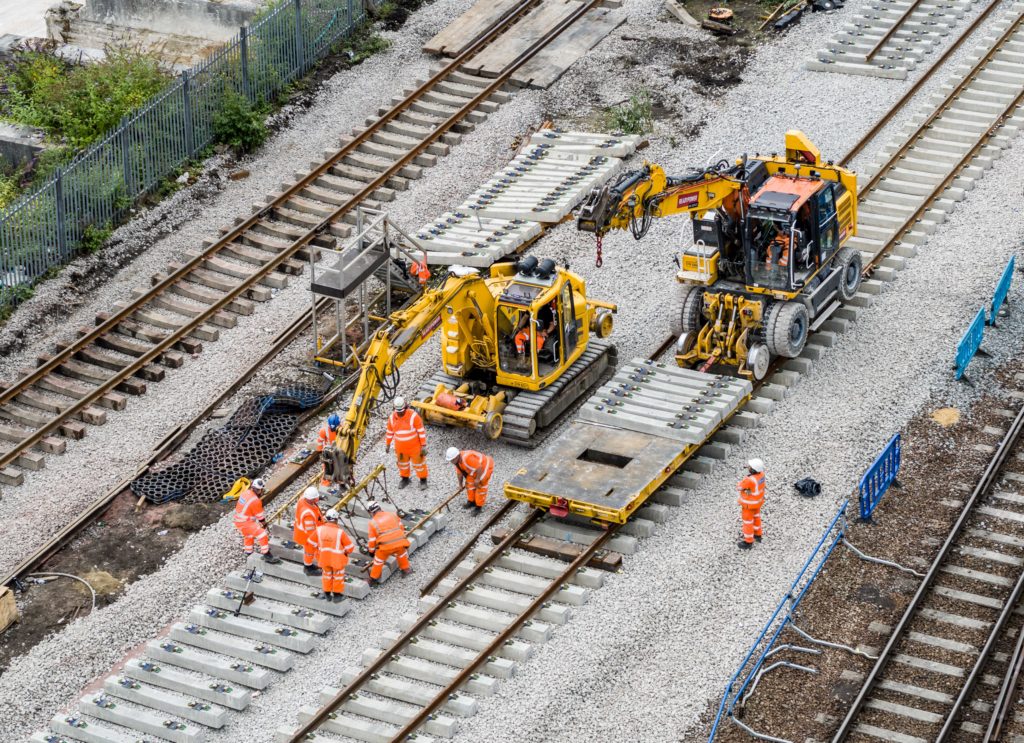A major step forward in improving train services between Manchester and York, as well as local services from Manchester Victoria, was achieved in August. The Transpennine Upgrade West Alliance (TRU-W) used a 16-day closure, from 31 July to 15 August, to carry out major bridge, track and signalling works between Manchester Victoria and Stalybridge.
The TRU-W Alliance is a partnership of Network Rail, Amey, Bam Nuttall, Siemens and Arup, formed to upgrade the transpennine route between Manchester Victoria and Leeds via Huddersfield. A partnership of Amey Consulting, and Arup carried out the design work for the scheme. There is another alliance, TRU-E, which is upgrading the route between Leeds and York.
Transpennine proposals
There has been a long history of various proposals for the transpennine route(s), including much debate in Parliament and stop/start approvals by the Secretary of State for Transport, over a period of several years. However, in 2017 a final design remit was agreed. The objectives of the upgrade were to achieve line speed increases, electrify the route in stages and achieve performance improvements, including signalling. The first section of the upgrade, specifically between Manchester Victoria and Miles Platting, was scheduled to commence in 2020, but was postponed, although some enabling works, such as utility and cable diversions were started in March 2020.
August Blockade

The two most significant works items scheduled for the August blockade were the reconstruction of part of the superstructure of the Dantzic Street underbridge, 400 metres east of Manchester Victoria and the reconstruction of one deck of the underbridge at Queens Road at Miles Platting on a new alignment. A primary reason for choosing the first two weeks of August to hold the blockade was the assumption that there was less chance of high wind speeds at that time. This choice of timing would reduce the risk of disruption to the operation of the large cranes deployed at Dantzic Street and Queens Road – a 600 tonne Liebherr crawler from Weldex and a 1000 tonne Liebherr mobile from Baldwins, respectively.
It was the work required at Dantzic Street that led to the decision to go for a 16-day blockade, explained Gerry O’Connor, programme delivery lead manager for TRU-W. Attempting the work in conventional weekend possessions would have required more than one weekend closure and the two lines concerned would have been unavailable in between. The section of the bridge needing renewal was the deck carrying the Rochdale Slow lines. This part of the superstructure lies at the centre of the six-track railway – bounded on the north side by the Rochdale Fast lines and on the south side by the Ashton lines (which are used by Metrolink at this location) – and is therefore relatively difficult to access. By arranging the 16-day closure, it was possible to take advantage of this period to efficiently carry out all the other civil engineering, track and signalling works throughout the section.

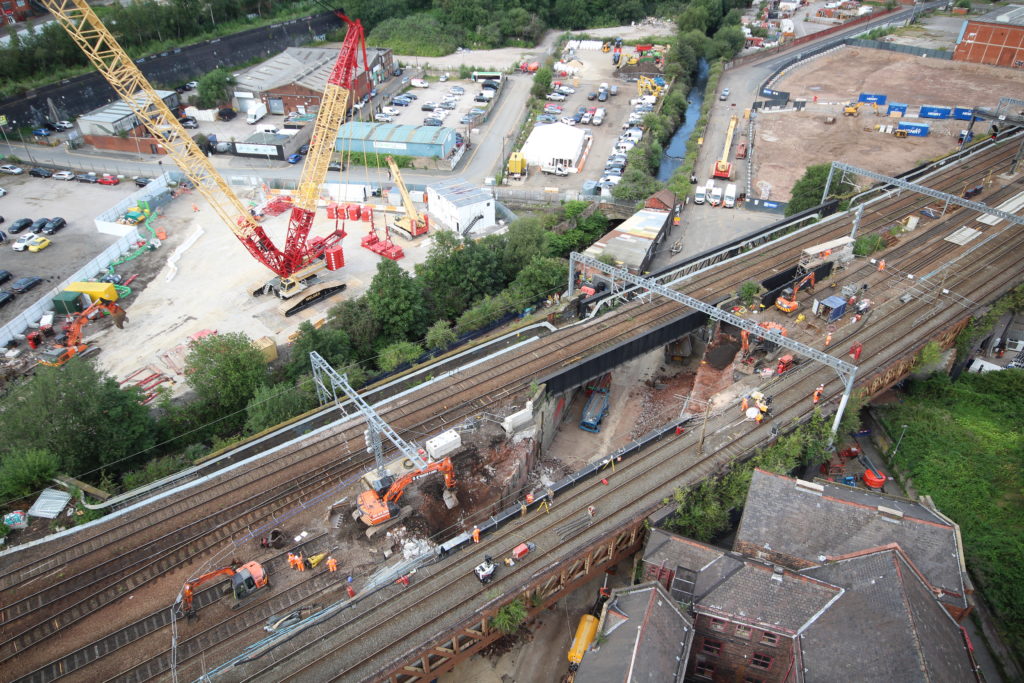
A total of 3,280 metres of track renewal was included in the work. The majority of the work varied between Network Rail’s Category 9 (reballasting) and Category 11 (like-for-like renewal with a 250mm dig). It also included 880 metres of renewal with enhanced depth dig and geotextile installation.
Seventeen new signals were installed in readiness for new signalling to be commissioned in June 2022, with further enhancement in 2023. The other works, apart from the two major bridge reconstructions, were the replacement of bridge decks for a pedestrian underpass at Bromley Street and the underbridge at Oldham Road; refurbishment of four switch and crossing sites; and the installation of points heaters along with several other minor works. In total, 26 engineering trains were used throughout the blockade for removal and delivery of materials.
The 16-day closure was not a simple blockade of all lines between Manchester Victoria and Stalybridge. In fact, there were many changes to the lines under possession at various times, to enable use of the routes by train operators as and where possible. For example, during the week, the Down Rochdale Fast line was reopened to traffic during morning and evening peak times, being used bidirectionally. This line was also opened during weekday nights and used in the Down direction only. These changes to the blockade limits were shown in detail on stage-by-stage slides, which were also used in advance for staff briefing and visualisation. There was good cooperation between TRU-W and Northern, GB Freight and Transpennine Express to achieve the optimum plan.

Dantzic Street redecking
The central deck of the underbridge at Dantzic Street, carrying the Up and Down Rochdale lines, required renewal. It is a heavily skewed structure. The renewal work involved removal of the old structure in a series of lift outs, followed by preparation of the brick abutments and then placement of concrete cill units in several sections. The new superstructure consists of two main beams, two trimmer beams and eleven deck units, all in weathering steel. Construction of the new deck was complete by midnight on 8 August and track reinstatement could commence.
An interesting innovation was to use a Trackstack 8042T Conveyor, familiar in quarrying and mining businesses, to transfer bottom ballast delivered by road up to track level. There was sufficient clearance between the Ashton Lines deck and the Rochdale lines deck to use this elevator. Track and signalling reinstatement were complete by the early hours of 13 August. Another advantage of the long blockade had been that it was possible to use the large crane to lift four 360° excavators up to track level. On this mostly elevated section of railway, there was no convenient level access by road for these machines.
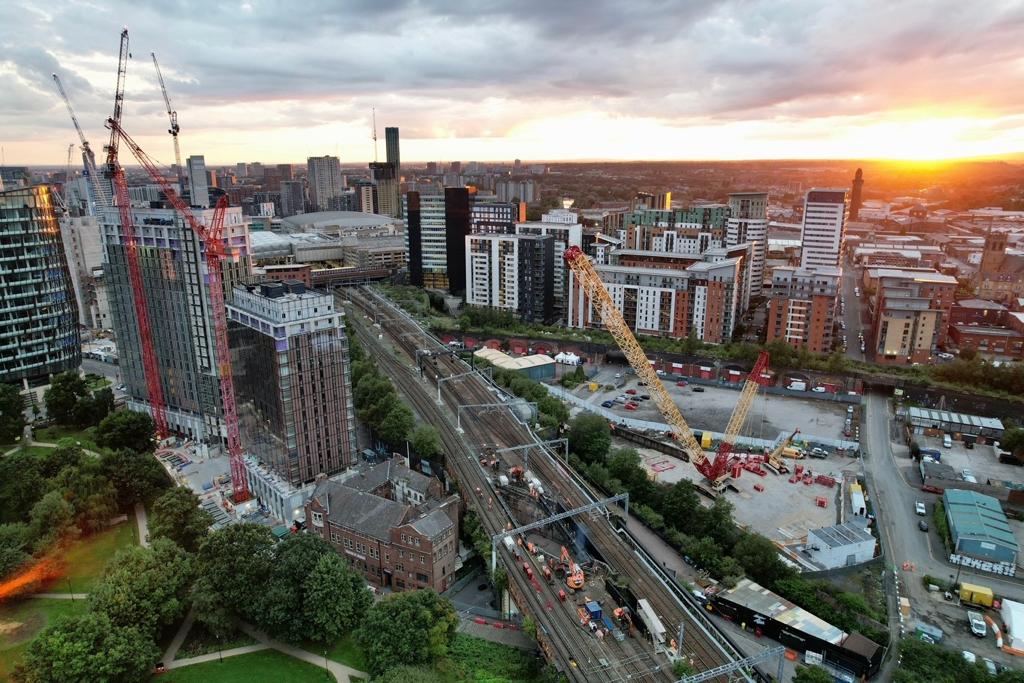
Realignment work at Miles Platting
The other major piece of work completed during the blockade was the realignment of the Ashton lines on the sharp curve at Miles Platting Junction, which enables a line speed increase from 30 to 50 mph in this location. This work had commenced some time prior to the August blockade with the construction of a widened embankment to provide a new formation to suit the new eased track alignment.
The crucial element of this scheme taking place during the blockade was the demolition of the Queens Road underbridge carrying the Ashton lines, provision of a new superstructure and track renewal on the new realignment. Prior to the blockade, the Queens Road underbridge abutments had been extended to cater for the new span, the wing walls constructed, and a few of the new beams installed where they were clear of the old superstructure.
The remainder of the new beams were in place by 6 August, the shear keys and deck completion following and then the replacement track all completed by 12 August. The new superstructure is a composite deck formed of reinforced concrete encased steel beams.
4D modelling
Advance planning of all these works to be carried out during the 16-day closure was refined using the Primavera P6 programming software. Five critical paths were identified. A striking and sophisticated enhancement of the planning process was the use of 4D modelling. This was enabled by linking the Primavera data to the Synchro system, which displays 3D views of each work site against an actual date/time stamp, hence the 4D terminology.
With all the information displayed on a Vimeo output, the actual planned situation in terms of construction progress, could be seen against any chosen date/time during the blockade. Once the project team had made adjustments to the programme and were satisfied with all its detail, the 4D models were used in advance of the blockade for staff briefing purposes. Also, and significantly, the 4D models were displayed on a wall of large screens available in the Control Room used during the blockade. The Control Room has six Nureva CleverTouch screens running off two computers. The data was cloud-hosted and shared via Microsoft Teams. This impressive facility enabled the project team to monitor actual progress on site, which was being fed in continuously to update the models. This arrangement made it far easier to modify the programme, if necessary, than it would otherwise have been.
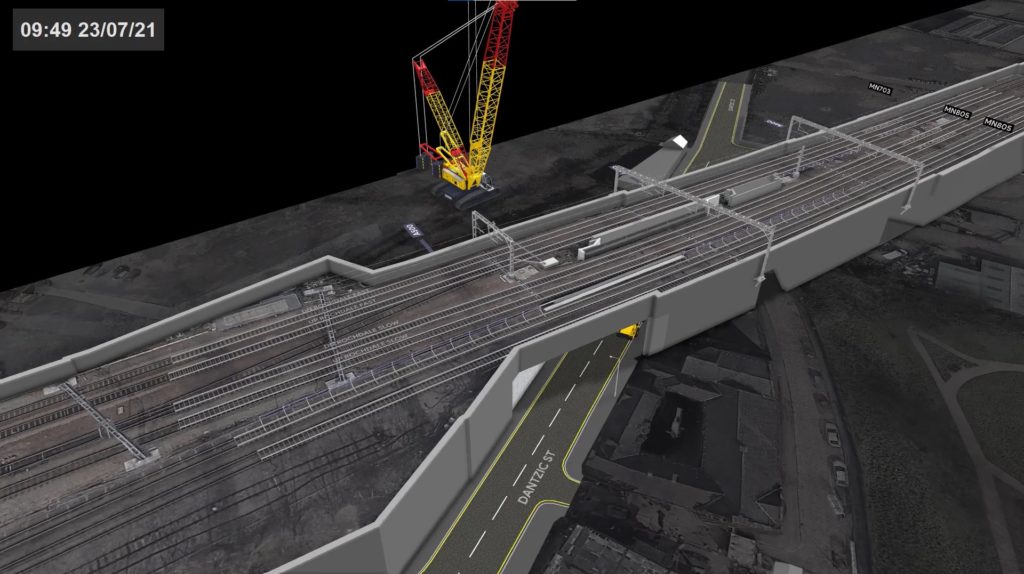
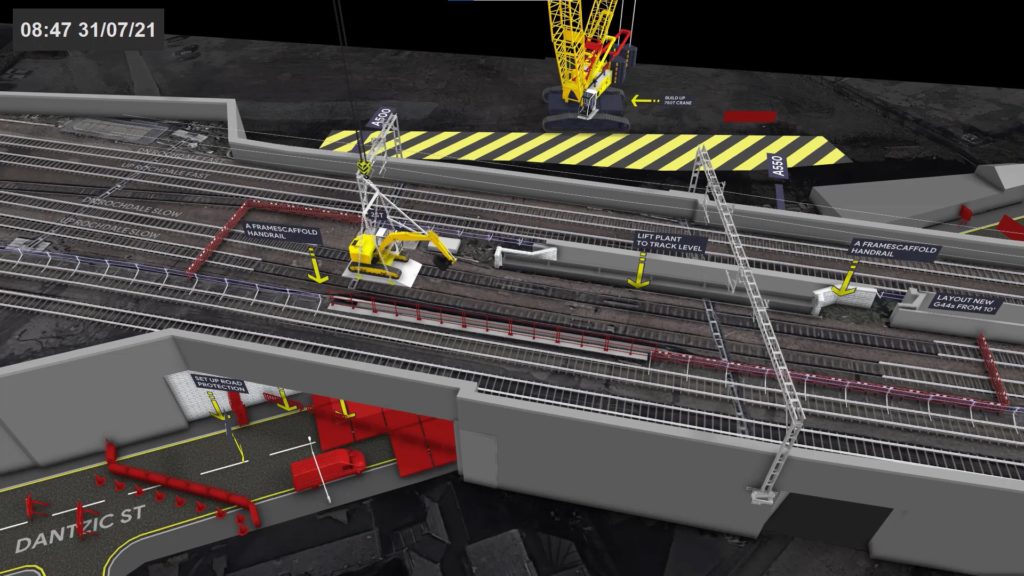

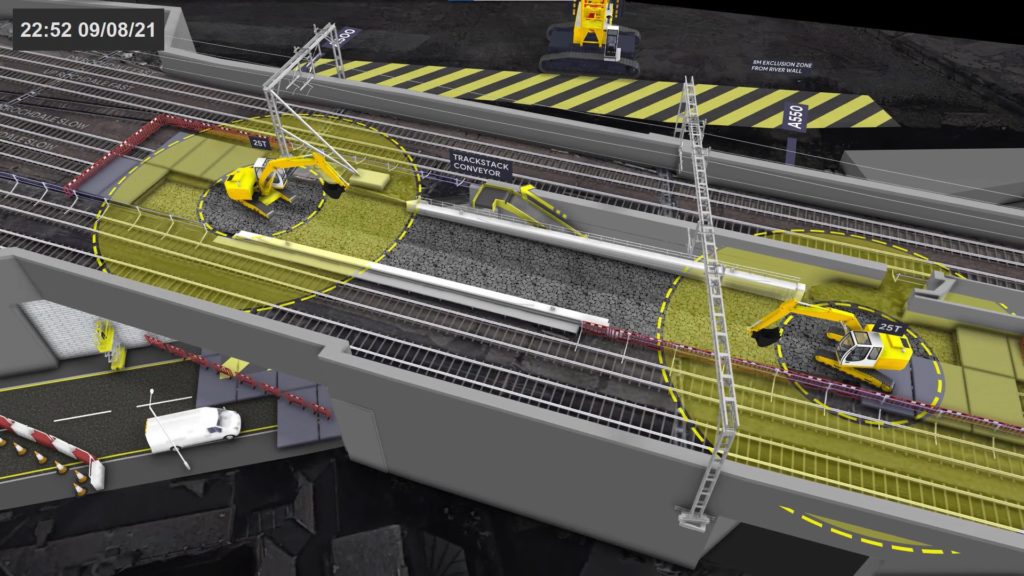
Resourcing
The TRU-W’s compound at Gorton Road is a splendidly well-appointed complex, with high quality site offices, canteen, messrooms, showers and other staff welfare facilities. The Covid-19 precautions are exemplary. Visitors must complete permissive access forms prior to their visit and then receive a temperature check on arrival. The pandemic meant that there was a delay in using the site compound to the full. In fact, home working was the norm up until November 2020 when it became possible to re-enter the workspace. The office capacity is for 200 staff. Initially, though, because of social distancing measures, only 50 could be accommodated. The capacity has since been gradually increased.
During the main blockade, there were between 400 and 500 staff on site at any time. Another effect of Covid-19 was the surge of notifications when the ‘pingdemic’ hit during July 2021. This did have an effect on planned resourcing, when some staff had to self-isolate, but was well managed by the team so as not to impact the programme.
Conclusion
Work to install foundations for electrification masts is now proceeding between Manchester Victoria and Stalybridge, and the new embankment at Queens Road is having its finishing touches of topsoil and seeding. These early works to upgrade the whole 76-mile route between Manchester and York, via Huddersfield and Leeds, are a great foretaste of what remains to be done. Rail Engineer will return to follow progress at many locations on this much heralded and long-awaited project.
